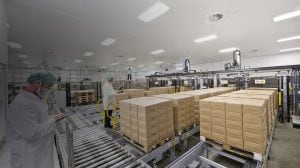June 21, 2019
Your internet browser isn't supported.
Discover new efficiencies with lighting that boosts productivity and safety
Modern LED technology is gaining traction across the manufacturing industry, seemingly at the speed of light. In fact, the LED adoption rate in industrial spaces is expected to skyrocket from just 3% in 2014 to a whopping 76% in 2020 and 80% in 2035, according to Frost and Sullivan.
As manufacturing facilities broaden their focus from streamlining processes, systems, and supply chain to include savings in the form of energy efficiency, long-lasting LED lighting fits the bill.
The benefits of LED factory lighting have become obvious. Features such as high efficiency, zero-maintenance, superior visibility and smart controls ensure manufacturers save on maintenance and energy expenses. With up to a 90% reduction in energy costs, an LED upgrade typically pays for itself in as little as two years.
Besides saving energy and maintenance costs, investing in LED technology and more robust controls allow manufacturers to easily meet or exceed lighting standards, boosting both productivity and safety.
LED Technology Drives Productivity
LED lighting is remarkably durable and requires zero maintenance, freeing workers for other tasks and improving manufacturing cycle times. But there are other, less obvious ways LED technology has the potential to boost productivity.
Consider the positioning of lighting: situated with a bird’s eye view of factory floors. When equipped with smart technology, LED lighting is in prime position to collect data that can help improve efficiency.
The latest smart LED technology even has the ability to track activity and items on the plant floor. No longer would auto manufacturing workers spend precious time searching for a missing cart of car parts, nor would valuable items get lost.
Another smart lighting feature that can benefit manufacturers is the ability to track traffic and occupancy patterns and provide adequate lighting to the areas where work is taking place. Because there’s no longer a need to adjust lighting manually, resources are freed for other tasks.
The new efficiencies that LED technology delivers help facilities run more smoothly. This is important to manufacturers who pride themselves on the quality of their products — as well as the safe conditions of their factories.
LED Technology Creates Safer Facilities
The same lighting technology that boosts productivity makes manufacturing facilities safer as well.
The same sensors and controls that help save lighting costs by collecting traffic data have the potential to inform other systems: for example, connecting wirelessly to HVAC systems, monitoring air quality and helping keep workers comfortable and safe.
Another example is lighting equipped with beacons that help prevent collisions of automated forklifts and robotics, whose use is becoming more widespread in plants.
Finally, the durability of LED fixtures makes them ideal for harsh conditions like those found in heavy manufacturing environments. Industrial LED lighting is resistant to both vibration and the often drastically varying temperatures of thermal environments where machinery is constructed. These fixtures aren’t fragile and will not break, lowering the likelihood of accidents due to outages.
Any increase in safety is an increase in cost savings down the road, making LED technology a wise investment for manufacturers.
Not only does investing in lighting improvements such industrial LED lighting and more robust controls boost energy savings, productivity, and safety — LED lighting systems are scalable, making them a smart long-term solution with benefits that amplify over time.
Ready to learn more about an LED technology solution for your manufacturing facility? Visit us HERE to learn more.

